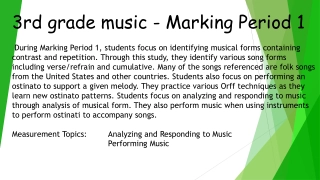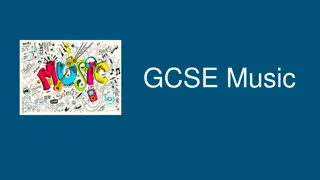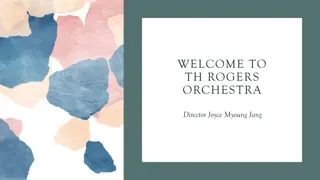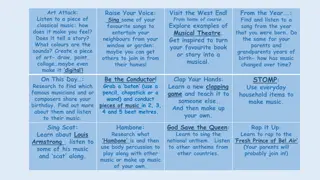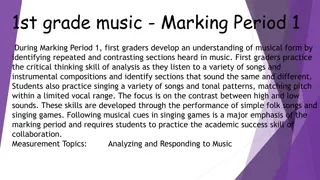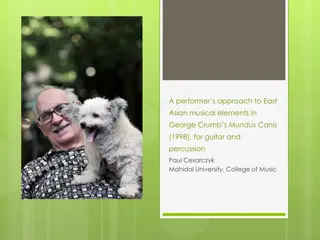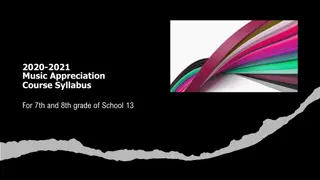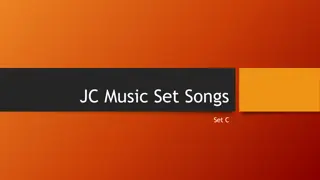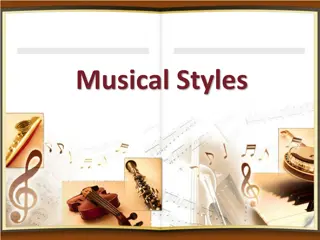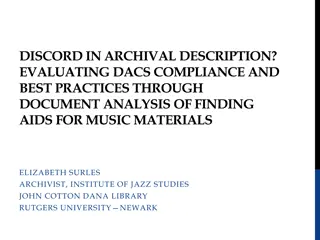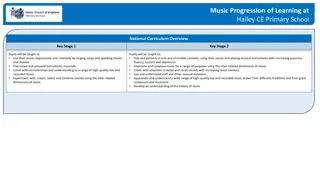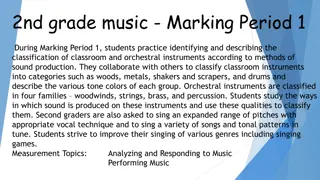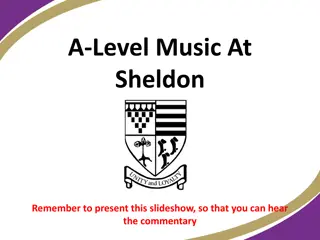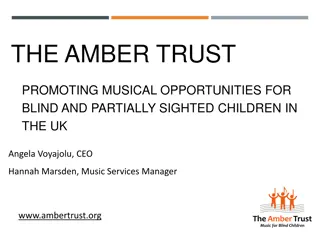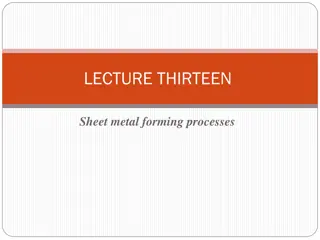Evaluating Musical Experience Through Gaze Tracking of Sheet Music Experiment
"This experiment focuses on correlating musical experience with the identification of sheet music pieces using eye tracking technology. The study aims to gauge how quickly individuals comprehend sheet music based on their level of musical expertise. Through the use of an eye tracker, participants are tasked with identifying various musical pieces, ranging from popular culture to classical compositions. The experiment delves into the nuances of music reading and aims to provide insights on musical experience assessment."
Download Presentation

Please find below an Image/Link to download the presentation.
The content on the website is provided AS IS for your information and personal use only. It may not be sold, licensed, or shared on other websites without obtaining consent from the author.If you encounter any issues during the download, it is possible that the publisher has removed the file from their server.
You are allowed to download the files provided on this website for personal or commercial use, subject to the condition that they are used lawfully. All files are the property of their respective owners.
The content on the website is provided AS IS for your information and personal use only. It may not be sold, licensed, or shared on other websites without obtaining consent from the author.
E N D
Presentation Transcript
P EVALUATING MUSICAL EXPERIENCE THROUGH GAZE TRACKING OF SHEET MUSIC PARKER MYSLOW, KIRUBHA RAJADHAS, MICHAEL PARKS
P INTRODUCTION Sheet music is a musical standard that has been used for centuries Sheet music provides a standardized format that almost any musician can read and understand Complicated sheet music can be difficult to learn and master With our experiment, we sought to find meaningful data correlating musical experience and identifying sheet music pieces using eye tracking
M BACKGROUND Humans struggle to visualize the notes they read from sheet music One of the main aspects of sheet music reading is alternating from saccades and fixations Most comprehension occurs during fixation time, 90% of music reading Understanding what people look at while reading music can help to better teach people how to read music more efficiently Experimental Question: Can musical experience be measured from speed of sheet music identification using eye tracking? Hypothesis: Musical experience can be gauged by the speed of sheet music comprehension. Experienced musicians should guess the piece faster, and novices should guess the piece slower.
M AREAS OF CONCERN Beginner musicians would not be able to identify any of the music Addition of bass clef to aid bass instrument and piano players Concern that participants would be overwhelmed without having lyrics or a title
K APPARATUS Gazepoint GP3 Eye Tracker Half a degree of accuracy (according to manufacturer) Tracks gaze of eyes and distance of eyes from screen at 60 Hz Stimuli were displayed on a Dell monitor with a refresh rate of 59 Hz
K PROCEDURE We started by giving every participant a pre-questionnaire which asked if they have any music experience, what instruments they played, and if they had any eyewear. Then we instructed the participants to follow the instructions on the stimuli and try their best to guess what song they are looking at based on the sheet music. Once they were done, we gave them a post questionnaire which asked how they felt about the sheet music and how hard they thought the overall experiment was.
P STIMULI The stimuli we used for this experiment was varied, stemming from pop culture and classical pieces, all varying in difficulty. The difficulty of the sheet was chosen based on frequency of notes, time signature, complexity of note patterns, and key. The first stimuli we used is Jingle Bells, a seemingly universally recognizable piece
STIMULI HAPPY BIRTHDAY SONG
STIMULI AMERICA THE BEAUTIFUL
STIMULI AMAZING GRACE
STIMULI STAR WARS THEME SONG
M RESULTS For Jingle Bells we had a 45% correct guess with an average time of 21.63 seconds, and minimum time of 4.58 seconds and maximum time of 30 seconds. For happy Birthday we had a 45% correct guess with an average time of 21.48 seconds, and minimum time of 7 seconds and maximum time of 30 seconds. For America, the Beautiful we had a 0% correct guess with an average time of 30 seconds, and minimum time of 30 seconds and maximum time of 30 seconds. For Amazing Grace, we had a 0.91% correct guess with an average time of 27.9 seconds, and minimum time of 7 seconds and maximum time of 30 seconds. For Star Wars we had a 54% correct guess with an average time of 18.82 seconds, and minimum time of 3 seconds and maximum time of 30 seconds.
M RESULTS Here is the fixation map of the expert musician who managed to guess music sheet. As you can see the expert spent most of his fixation time looking at the first few notes on the treble clef. In the pre interview questions the expert said they play the guitar which explains why most of their fixations were on the treble clef.
K RESULTS Here you can see the fixation of someone who had no prior music sheet reading knowledge. The participant had almost no fixation and spent most of the time looking at the center of the notes. The participant guessed 0/5 of the sheet music pieces.
K RESULTS This participant has some experience with music reading. As you can see, they spent most of their fixation looking at the top left of the music sheet and the treble clef. This is similar behavior to our expert music reader. This participant guessed of the music sheets.
P CONCLUSION From the experiments, we concluded that the music perceived difficulty level had little effect on people that can read sheet music. For example, more people were able to guess Star Wars sheet music correctly over Jingle Bells or Happy Birthday. Participants that guessed most music correctly spent most of their fixation on the first few notes. The participants that had no prior experience in how to read music rarely had any fixation and spent most of the time looking at the center of the sheet music. Question: Was musical experience measurable from the speed at which our subjects identified the sheet music pieces? Answer: Hypothesis somewhat supported by results of experienced musicians and novices
REFERENCES Eye Movements and Music Reading: Where Do We Look Next? Jaime Madell; Sylvie H bert Music Perception (2008) 26 (2): 157 170. https://doi.org/10.1525/mp.2008.26.2.157 Goolsby TW (1987) The parameters of eye movement in vocal music reading. Doctoral dissertation, University of Illinois at Urbana-Champaign, AAC8721641


